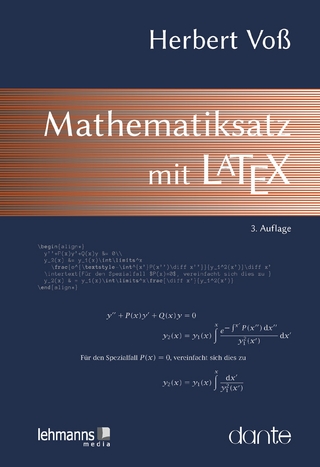Protocol Engineering
Springer Berlin (Verlag)
978-3-642-29144-9 (ISBN)
Communication protocols form the operational basis of computer networks and telecommunication systems. They are behavior conventions that describe how communication systems interact with each other, defining the temporal order of the interactions and the formats of the data units exchanged - essentially they determine the efficiency and reliability of computer networks. Protocol Engineering is an important discipline covering the design, validation, and implementation of communication protocols.
Part I of this book is devoted to the fundamentals of communication protocols, describing their working principles and implicitly also those of computer networks. The author introduces the concepts of service, protocol, layer, and layered architecture, and introduces the main elements required in the description of protocols using a model language. He then presents the most important protocol functions. Part II deals with the description of communication protocols, offering an overview of the various formal methods, the essence of Protocol Engineering. The author introduces the fundamental description methods, such as finite state machines, Petri nets, process calculi, and temporal logics, that are in part used as semantic models for formal description techniques. He then introduces one representative technique for each of the main description approaches, among others SDL and LOTOS, and surveys the use of UML for describing protocols. Part III covers the protocol life cycle and the most important development stages, presenting the reader with approaches for systematic protocol design, with various verification methods, with the main implementation techniques, and with strategies for their testing, in particular with conformance and interoperability tests, and the test description language TTCN. The author uses the simple data transfer example protocol XDT (eXample Data Transfer) throughout the book as a reference protocolto exemplify the various description techniques and to demonstrate important validation and implementation approaches.
The book is an introduction to communication protocols and their development for undergraduate and graduate students of computer science and communication technology, and it is also a suitable reference for engineers and programmers. Most chapters contain exercises, and the author's accompanying website provides further online material including a complete formal description of the XDT protocol and an animated simulation visualizing its behavior.
Prof. Hartmut König holds the chair in Computer Networks and Communication Systems at the Brandenburg University of Technology (btu) in Cottbus. He has published over 100 research papers and articles, and authored or edited 7 books in the area of communuications and distributed systems. His research interests include high-performance communications (multimedia communication, videoconferencing), protocol engineering (automatic implementation, test), formal methods, and network security (intrusion detection).
Part I - Principles of Communication Protocols.- Chap. 1 - Services.- Chap. 2 - Protocols.- Chap. 3 - Layers.- Chap. 4 - Layered Architectures.- Chap. 5 - Protocol Functions.- Chap. 6 - Case Study: The Internet Protocol Stack.- Part II - Description of Communication Protocols.- Chap. 7 - Formal Description Methods.- Chap. 8 - Formal Description Techniques.- Part III - Development of Communication Protocols.- Chap. 9 - Protocol Development Process.- Chap. 10 - Design.- Chap. 11 - Verification.- Chap. 12 - Performance Evaluation.- Chap. 13 - Implementation.- Chap. 14 - Testing.- Chap. 15 - Outlook.- Glossary.- References.- Abbreviations.- Index.
From the reviews:
"This book is a good introduction to the engineering of communication protocols. ... will be useful to graduate students taking courses in data communication and computer networks." (Sathiamoorthy Manoharan, Computing Reviews, January, 2014)
"König (computer networks and communication systems, Brandenburg Univ. of Technology, Germany) has authored numerous works on protocols and communications, and is thus well qualified to write this work. He succeeds in delivering a book that adeptly covers the basics of protocols, formal protocol descriptions, and the protocol life cycle. ... The book is quite readable and could serve as a good introduction to protocol engineering. ... Overall, the book is well worth reading. Summing Up: Highly recommended. Upper-division undergraduates and above." (L. McLauchlan, Choice, Vol. 50 (11), August, 2013)| Erscheint lt. Verlag | 9.10.2012 |
|---|---|
| Zusatzinfo | XVI, 528 p. |
| Verlagsort | Berlin |
| Sprache | englisch |
| Maße | 155 x 235 mm |
| Gewicht | 942 g |
| Themenwelt | Mathematik / Informatik ► Informatik ► Betriebssysteme / Server |
| Mathematik / Informatik ► Informatik ► Netzwerke | |
| Mathematik / Informatik ► Informatik ► Software Entwicklung | |
| Schlagworte | algebraic verification • ASN.1 • Communication Protocols • conformance test • cTLA • finite state machines • formal description methods • Formal Description Techniques • internet protocol stack • interoperability test • layered architectures • Lotos • Model Checking • MSC • Netzwerkprotokoll • Performance Evaluation • petri net analysis • Petri Nets • process calculi • protocol design • protocol functions • protocol implementation methods • protocol life cycle • protocols • protocol specification • protocol testing • Protocol Verification • Reachability Analysis • SDL • Services • Temporal Logics • TTCN-2 • TTCN-3 • UML 2 • UML (Unified Modeling Language) |
| ISBN-10 | 3-642-29144-9 / 3642291449 |
| ISBN-13 | 978-3-642-29144-9 / 9783642291449 |
| Zustand | Neuware |
| Haben Sie eine Frage zum Produkt? |
aus dem Bereich




